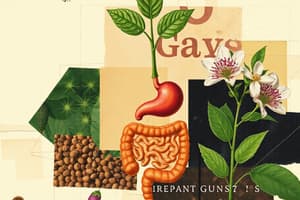Podcast
Questions and Answers
What is the main function of the xylem in plants?
What is the main function of the xylem in plants?
- Facilitating photosynthesis in the plant
- Transporting water and minerals from roots to the rest of the plant (correct)
- Transporting sugars from leaves to other parts of the plant
- Facilitating transpiration in the leaves
Which process is responsible for replacing water lost through transpiration in plants?
Which process is responsible for replacing water lost through transpiration in plants?
- Respiration
- Transpiration (correct)
- Photosynthesis
- Translocation
What is the main function of the phloem in plants?
What is the main function of the phloem in plants?
- Transporting sugars from leaves to other parts of the plant (correct)
- Absorbing water and minerals from the soil
- Facilitating transpiration in the leaves
- Facilitating photosynthesis in the plant
Which part of the plant is primarily responsible for the production of sugars used in energy production?
Which part of the plant is primarily responsible for the production of sugars used in energy production?
What is essential for providing energy to all parts of a plant?
What is essential for providing energy to all parts of a plant?
Which organelle is primarily responsible for cellular respiration in plant cells?
Which organelle is primarily responsible for cellular respiration in plant cells?
Which plant hormone is primarily responsible for promoting cell growth and elongation?
Which plant hormone is primarily responsible for promoting cell growth and elongation?
What is the main purpose of the citric acid cycle in plants?
What is the main purpose of the citric acid cycle in plants?
How do most plants reproduce sexually?
How do most plants reproduce sexually?
Which environmental factor can plants detect and respond to by adjusting physiological processes?
Which environmental factor can plants detect and respond to by adjusting physiological processes?
Flashcards are hidden until you start studying
Study Notes
Science: Exploring Life in Plants
Plants are intricate organisms that form the basis of our ecosystems, and they're far more than just green decorations. They're involved in complex processes that allow them to grow, reproduce, and survive. In this article, we'll delve into the science of plants, focusing on their transportation systems, respiration, and the various life processes they engage in.
Transportation in Plants
Plants have no circulatory system like animals do, so they've developed alternative methods for transporting water, nutrients, and other essential substances. The main site for this transport is the vascular tissue, primarily the xylem and phloem.
Xylem is responsible for transporting water and minerals from the roots to the rest of the plant. Water enters the roots through tiny openings called root hairs, then travels upwards through the xylem vessels, which are made up of long, hollow tubes. This water is absorbed into the xylem through a process called transpiration, where water evaporates from the leaves and is replaced with more water from the roots.
Phloem is responsible for transporting sugars that plants produce through photosynthesis. The sugars are made in the leaves and travel downwards through the phloem vessels, which are made up of living cells. This transport process is called translocation, and it's essential for providing energy to all parts of the plant.
Respiration in Plants
Plants, like animals, require energy to survive. While they mainly get their energy through photosynthesis, they also need respiration to release energy stored in food molecules. Unlike animals, plants primarily undergo cellular respiration, which takes place in the mitochondria of plant cells.
In plants, cellular respiration occurs in two main stages: glycolysis and the citric acid cycle (also known as the Krebs cycle or TCA cycle). During glycolysis, glucose is broken down into two molecules of pyruvate, which then enter the citric acid cycle. This cycle releases energy in the form of ATP (adenosine triphosphate), which plants use for their various life processes.
Life Processes
Plants engage in several life processes, including growth, reproduction, and response to environmental stimuli.
Growth is the increase in size or mass of an organism due to an increase in cell number or size. In plants, growth is facilitated by photosynthesis, which produces energy and building blocks for new cells. Plant growth is also controlled by plant hormones such as auxins, gibberellins, and cytokinins.
Reproduction is the process by which new plants are produced. Most plants reproduce sexually, producing flowers and seeds. The flowers contain male and female reproductive structures, while the seeds contain the embryo of a new plant and a protective covering called the seed coat. Some plants, such as ferns and bryophytes, reproduce asexually by forming new plants from their spores.
Response to environmental stimuli is the ability of plants to adapt to their environment. Plants can detect environmental factors like light, temperature, and water availability, and respond to these factors by adjusting their growth, development, and physiological processes. For example, plants can move their leaves to face the best light source, close their stomata to conserve water, or produce more pigments to protect themselves from UV light.
In conclusion, plants are complex organisms that engage in various life processes. They transport water and nutrients through specialized structures and undergo cellular respiration to release energy, which they use for growth, reproduction, and response to environmental stimuli. Understanding these processes helps us appreciate the intricate ways in which plants thrive and survive in our world.
Studying That Suits You
Use AI to generate personalized quizzes and flashcards to suit your learning preferences.




